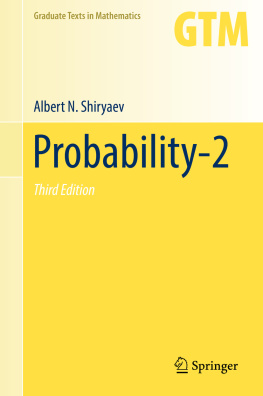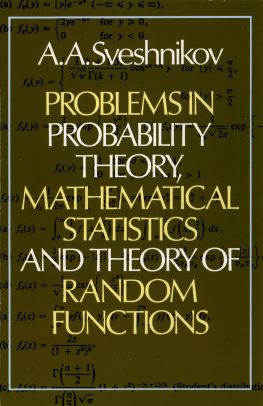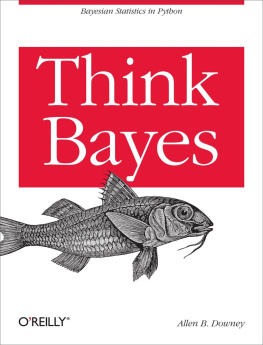WILEY SERIES IN PROBABILITY AND STATISTICS
Established by WALTER A. SHEWHART and SAMUEL S. WILKS
Editor: David J. Balding, Noel A. C. Cressie, Garrett M. Fitzmaurice, Harvey Goldstein, Ian M. Johnstone, Geert Molenberghs, David W. Scott, Adrian F. M. Smith, Ruey S. Tsay, Sanford Weisberg
Editors Emeriti: Vic Barnett, J. Staurt Hunter, Joseph B. Kadane, Jozef L. Teugels
A complete list of the titles in this series appears at the end of this volume.
Copyright 2014 by John Wiley & Sons, Inc. All rights reserved.
Published by John Wiley & Sons, Inc., Hoboken, New Jersey.
Published simultaneously in Canada.
No part of this publication may be reproduced, stored in a retrieval system, or transmitted in any form or by any means, electronic, mechanical, photocopying, recording, scanning, or otherwise, except as permitted under Section 107 or 108 of the 1976 United States Copyright Act, without either the prior written permission of the Publisher, or authorization through payment of the appropriate per-copy fee to the Copyright Clearance Center, Inc., 222 Rosewood Drive, Danvers, MA 01923, (978) 750-8400, fax (978) 750-4470, or on the web at www.copyright.com . Requests to the Publisher for permission should be addressed to the Permissions Department, JohnWiley & Sons, Inc., 111 River Street, Hoboken, NJ 07030, (201) 748-6011, fax (201) 748-6008, or online at http://www.wiley.com/go/permission .
Limit of Liability/Disclaimer of Warranty: While the publisher and author have used their best efforts in preparing this book, they make no representations or warranties with respect to the accuracy or completeness of the contents of this book and specifically disclaim any implied warranties of merchantability or fitness for a particular purpose. No warranty may be created or extended by sales representatives or written sales materials. The advice and strategies contained herein may not be suitable for your situation. You should consult with a professional where appropriate. Neither the publisher nor author shall be liable for any loss of profit or any other commercial damages, including but not limited to special, incidental, consequential, or other damages.
For general information on our other products and services or for technical support, please contact our Customer Care Department within the United States at (800) 762-2974, outside the United States at (317) 572-3993 or fax (317) 572-4002.
Wiley also publishes its books in a variety of electronic formats. Some content that appears in print may not be available in electronic formats. For more information about Wiley products, visit our web site at www.wiley.com .
Library of Congress Cataloging-in-Publication Data:
Zacks, Shelemyahu, 1932- author.
Examples and problems in mathematical statistics / Shelemyahu Zacks.
pages cm
Summary: This book presents examples that illustrate the theory of mathematical statistics and details how to apply the methods for solving problems Provided by publisher.
Includes bibliographical references and index.
ISBN 978-1-118-60550-9 (hardback)
1. Mathematical statisticsProblems, exercises, etc. I. Title.
QC32.Z265 2013
519.5dc23
2013034492
ISBN: 9781118605509
To my wife Hanna,
our sons Yuval and David,
and their families, with love.
Preface
I have been teaching probability and mathematical statistics to graduate students for close to 50 years. In my career I realized that the most difficult task for students is solving problems. Bright students can generally grasp the theory easier than apply it. In order to overcome this hurdle, I used to write examples of solutions to problems and hand it to my students. I often wrote examples for the students based on my published research. Over the years I have accumulated a large number of such examples and problems. This book is aimed at sharing these examples and problems with the population of students, researchers, and teachers.
The book consists of nine chapters. Each chapter has four parts. The first part contains a short presentation of the theory. This is required especially for establishing notation and to provide a quick overview of the important results and references. The second part consists of examples. The examples follow the theoretical presentation. The third part consists of problems for solution, arranged by the corresponding sections of the theory part. The fourth part presents solutions to some selected problems. The solutions are generally not as detailed as the examples, but as such these are examples of solutions. I tried to demonstrate how to apply known results in order to solve problems elegantly. All together there are in the book 167 examples and 431 problems.
The emphasis in the book is on statistical inference. The first chapter on probability is especially important for students who have not had a course on advanced probability. Chapter Two is on the theory of distribution functions. This is basic to all developments in the book, and from my experience, it is important for all students to master this calculus of distributions. The chapter covers multivariate distributions, especially the multivariate normal; conditional distributions; techniques of determining variances and covariances of sample moments; the theory of exponential families; Edgeworth expansions and saddlepoint approximations; and more. Chapter Three covers the theory of sufficient statistics, completeness of families of distributions, and the information in samples. In particular, it presents the Fisher information, the KullbackLeibler information, and the Hellinger distance. Chapter Four provides a strong foundation in the theory of testing statistical hypotheses. The Wald SPRT is discussed there too. Chapter Five is focused on optimal point estimation of different kinds. Pitman estimators and equivariant estimators are also discussed. Chapter Six covers problems of efficient confidence intervals, in particular the problem of determining fixedwidth confidence intervals by twostage or sequential sampling. Chapter Seven covers techniques of large sample approximations, useful in estimation and testing. Chapter Eight is devoted to Bayesian analysis, including empirical Bayes theory. It highlights computational approximations by numerical analysis and simulations. Finally, Chapter Nine presents a few more advanced topics, such as minimaxity, admissibility, structural distributions, and the Steintype estimators.
I would like to acknowledge with gratitude the contributions of my many exstudents, who toiled through these examples and problems and gave me their important feedback. In particular, I am very grateful and indebted to my colleagues, Professors A. Schick, Q. Yu, S. De, and A. Polunchenko, who carefully read parts of this book and provided important comments. Mrs. Marge Pratt skillfully typed several drafts of this book with patience and grace. To her I extend my heartfelt thanks. Finally, I would like to thank my wife Hanna for giving me the conditions and encouragement to do research and engage in scholarly writing.
SHELEMYAHU ZACKS
List of Random Variables
| B ( n , p ) | Binomial, with parameters n and p |
| E () | Exponential with parameter |
| EV (, ) | Extreme value with parameters and |
| F ( v , v ) | Central F with parameters v and v |
| F ( n , n ;) | Noncentral F with parameters v , v , |
| G (, p ) | Gamma with parameters and p |

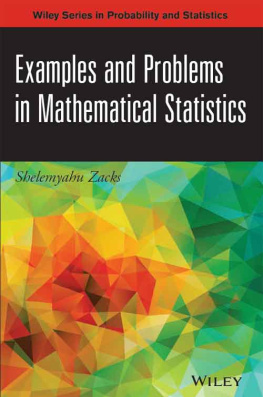

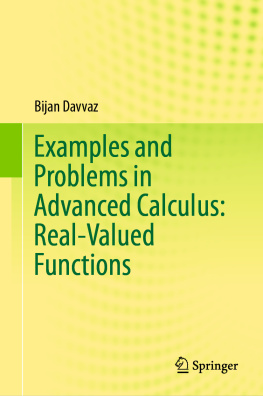


![Eugene Demidenko [Eugene Demidenko] - Advanced Statistics with Applications in R](/uploads/posts/book/153879/thumbs/eugene-demidenko-eugene-demidenko-advanced.jpg)
